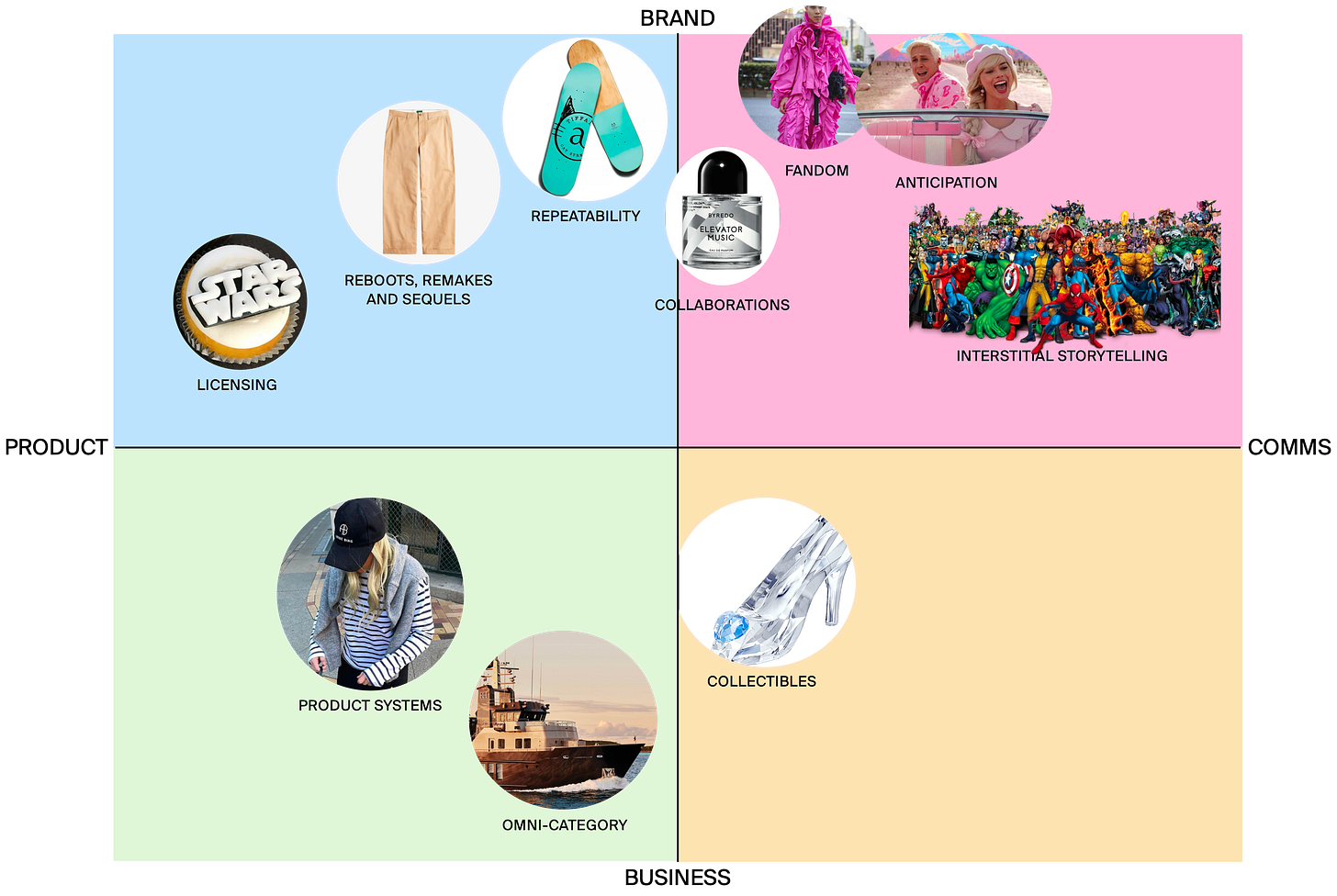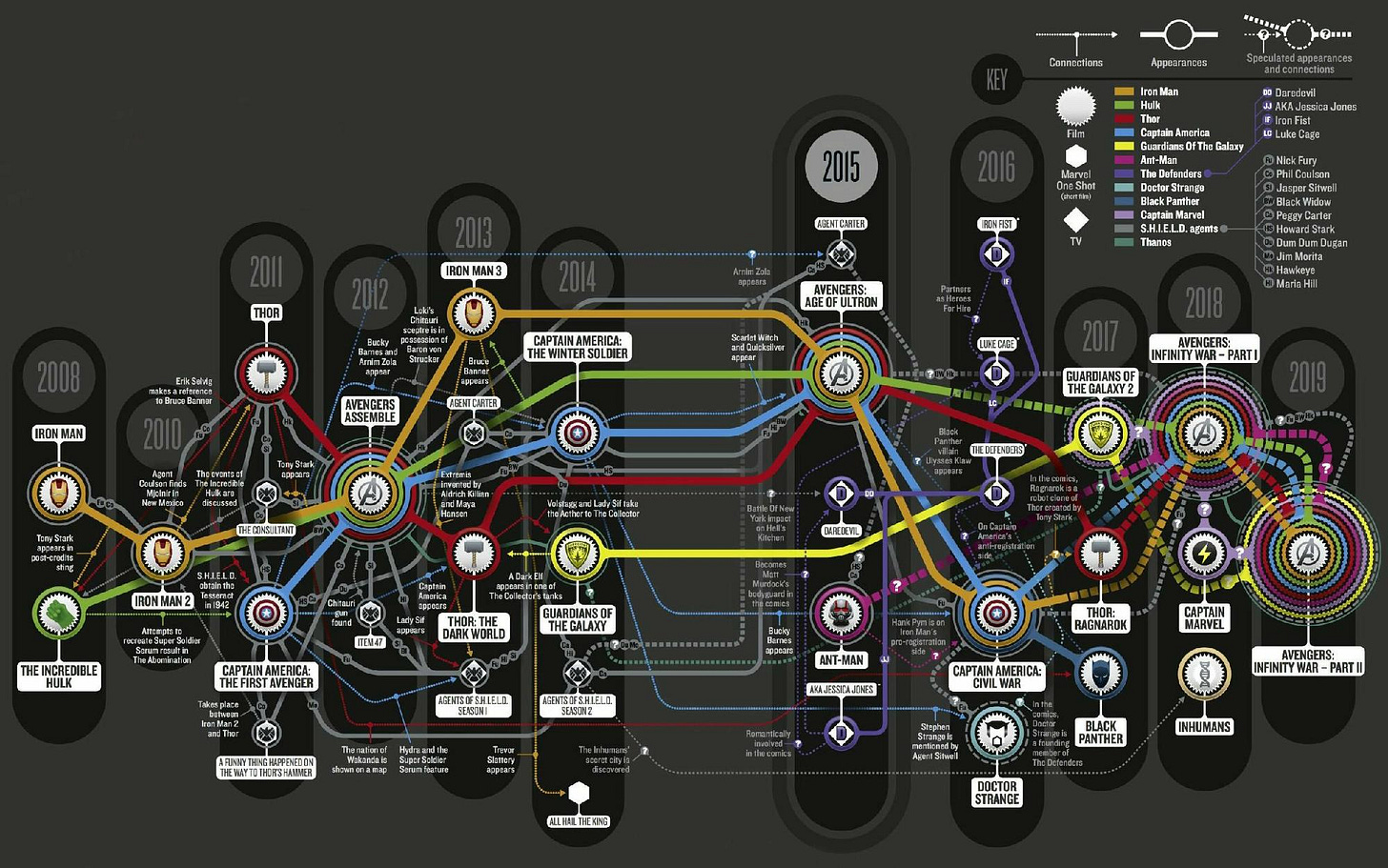Welcome to the Sociology of Business. For those new here, in my last analysis, Holistic brand management is the new marketing, I explore the role of marketing and why it goes across organizational silos. Find my book The Business of Aspiration on Amazon and find me on Instagram, Twitter, and Threads.
In the past decade, Marvel and Mattel popularized a model of brand-building that capitalizes on a brand’s intellectual property. Pioneered by Disney, and turbocharged by the recent Mattel’s Barbie movie, the model is now spreading from entertainment to other categories, like retail.
In retail, IP-driven growth strategy is to build, manage, amplify and monetize a brand’s past and present intellectual property. Their creative model is entertainment and customer management is fandom.
In addition to manufacturing products, IP-focused retail brands manufacture merch, partnerships, collaborations, licenses, experiences, reboots, sequels and fandom. Their revenue comes from product sales, services, and also licensing fees and percentage of partner product sales.
IP-focused retail brands have in common their positioning at the intersection of fashion and popular culture - their output is fashion as much as culture (e.g. Pharrell’s LV show; Met Galas; Telfar performances). Their new revenue stream is monetization of their intellectual property (signature design codes, logos, or signature items) and building worlds that extend beyond the original category to touch every facet of the modern life experience.
Strategically, they are governed by the following rules in the areas of marketing, product design, customer relationship management, creative, merchandising and business growth:
Interstitial Storytelling
Interstitial storytelling refers to a number of narrative bursts that are connected into a web of a wider story. A story is told as a series, with each piece of content containing germs of the next story and ending with a cliffhanger. For retail brands, this means releasing collections like movies, starting with teaser trailers, then trailers, then marketing activations, with the role of building anticipation for a collection release, rather than marketing a collection once it is available.
Anticipation
Powered by interstitial storytelling, anticipation is based on narrative discovery. A teaser and a trailer drive narrative discovery of the movie they promote. Video game levels and challenges drive narrative discovery of a game world. In retail, anticipation is the result of the narrative discovery of a collection, a brand vision, or a collaboration or partnership. But more than an actual collection, of interest is the anticipation itself, powered by sneak peeks, previews, leaks, teasers and trailers in place of campaign videos. The wait is the game; a collection is less important than the content announcing it.
Repeatability
Repeatable narrative anchors create familiarity and rhythm in expectations. Narrative anchors are recognizable codes and style signifiers, like color (Barbie pink, Tiffany blue), design details (red soles for Louboutin, Chanel tweed, Gucci logo) or brand handwriting (travel - real or imagined - for Louis Vuitton, horse-riding for Hermès). They are present across seasons and continuous over the years.
Fandom
It is not enough for brands to have customers; in order to grow and stay relevant, they need fans. Fans are going to watch every teaser and trailer and go to Reddit to decode signs and chat about a brand with others. Fans are the biggest driver for monetizing a brand’s intellectual property.
Licensing
Fandom is the most easily activated, built and nurtured through licensing. Licensing brand experience, logo, and aesthetics carries a brand into new cultural territories. It is not hard to imagine a Chanel experience, or a Cucinelli experience, or a Rick Owens experience, where brands are licensing not their logos, but their bespoke brand worlds. For a fee, a resort can provide Fendi breakfasts or LOEWE craft workshops. We are already in this territory, with celebrities having their branded weddings (Sofia Richie in Chanel, Kourtney Kardashian in D&G) and Kim Kardashian curating 1990s Dolce&Gabbana looks for her 2023 Collection.
Please choose one of the paid subscription options to access the analysis of the remaining five rules of IP brands - collaborations, product systems, reboots and sequels, collectibles and brand worlds.
Keep reading with a 7-day free trial
Subscribe to The Sociology of Business to keep reading this post and get 7 days of free access to the full post archives.










